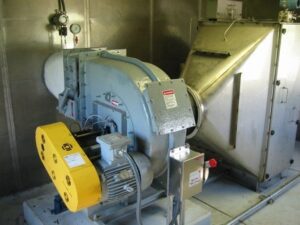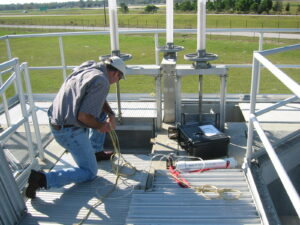Why Diffusion Matters in Wastewater Treatment
 Aeration is one of the most important processes in a wastewater treatment plant. It gives the microorganisms in the activated sludge the oxygen they need to break down organic material. Without enough oxygen, treatment performance drops, odors increase, and corrosion risks rise. Activated sludge diffusion is a method that keeps oxygen levels where they need to be, supporting both efficient treatment and odor reduction.
Aeration is one of the most important processes in a wastewater treatment plant. It gives the microorganisms in the activated sludge the oxygen they need to break down organic material. Without enough oxygen, treatment performance drops, odors increase, and corrosion risks rise. Activated sludge diffusion is a method that keeps oxygen levels where they need to be, supporting both efficient treatment and odor reduction.
At Webster Environmental Associates (WEA), we have worked with wastewater plants of all sizes to improve aeration and manage odor. Many facilities come to us when their current aeration systems are not performing as expected or when community odor complaints increase. By looking at both treatment needs and odor control, we help plants find practical ways to improve operations.
The Basics of Activated Sludge Diffusion
Activated sludge diffusion is the process of adding air into wastewater through small bubbles. The air moves through diffuser grids or membranes at the bottom of tanks or basins. These bubbles transfer oxygen into the liquid, where the microorganisms in the sludge use it to break down organic matter.
Proper oxygen transfer is critical for more than just treatment. When oxygen levels drop too low, anaerobic conditions can form. These conditions allow certain bacteria to create hydrogen sulfide gas, which causes strong odors and can corrode equipment. By maintaining good diffusion and oxygen levels, plants reduce odor generation at the source.
Diffusion systems are designed with multiple components that work together. Diffusers, piping, blowers, and controls all need to be properly sized and maintained to keep the process efficient. Even small design issues can affect performance and lead to higher energy use or odor problems.
Operational Benefits for Wastewater Facilities
A well-designed and maintained activated sludge diffusion system provides clear benefits. First, it improves oxygen transfer efficiency. This means that microorganisms can work at their best, breaking down organic material faster and more reliably.
Second, better aeration leads to lower energy costs. Many plants spend a large portion of their energy budget on aeration. If airflow is uneven or oxygen transfer is poor, blowers must work harder to achieve the same results. Improving diffusion can reduce that demand.
Third, odor control improves naturally when the system maintains consistent oxygen levels. Hydrogen sulfide and other odor-causing gases form in low-oxygen conditions. By preventing these conditions, plants avoid many odor complaints without having to rely only on chemical treatment.
Common Challenges and How to Address Them
 Even the best diffusion systems face challenges over time. One common issue is fouling of diffuser grids. Solids and biological growth can reduce airflow and create uneven oxygen distribution. Routine inspection and cleaning help prevent these problems.
Even the best diffusion systems face challenges over time. One common issue is fouling of diffuser grids. Solids and biological growth can reduce airflow and create uneven oxygen distribution. Routine inspection and cleaning help prevent these problems.
Another challenge is over- or under-aeration. If airflow is too low, odors can form and treatment slows down. If it is too high, energy is wasted and diffuser life may shorten. Balancing airflow requires data and monitoring, not guesswork.
Seasonal changes or shifts in plant load can also impact performance. For example, warmer temperatures can speed up biological activity, increasing oxygen demand. Planning for these variations helps keep the system running effectively year-round.
How WEA Supports Diffusion System Optimization
WEA specializes in evaluating and improving activated sludge diffusion for both treatment and odor control. We start with a full field evaluation, measuring airflow and oxygen transfer across the system. If odor is a concern, we also perform air and liquid sampling to identify potential sources.
We can integrate diffusion improvements with other odor management strategies, such as chemical scrubbers, biofilters, or liquid-phase treatment. Our goal is to create a plan that fits the facility’s layout, budget, and operational needs.
Maintenance planning is another key part of our support. We provide recommendations for diffuser inspection schedules, cleaning routines, and airflow adjustments. By planning ahead, plants can avoid sudden performance drops or unexpected odor events.
Optimize Your Activated Sludge Diffusion with WEA
Activated sludge diffusion is a critical part of both wastewater treatment and odor management. When it works properly, it improves biological performance, reduces energy use, and lowers the risk of hydrogen sulfide formation. When it struggles, treatment efficiency drops and odors can escape into the surrounding community.
WEA has decades of experience helping facilities get the most from their aeration and odor control systems. Our team combines field testing, data analysis, and practical recommendations to improve performance without unnecessary cost.
If your plant is facing aeration challenges or community odor complaints, now is the time to review your diffusion system. Contact WEA to schedule an aeration audit or a full odor management assessment. We can help you plan upgrades, improve system reliability, and protect both your facility and the surrounding community.
